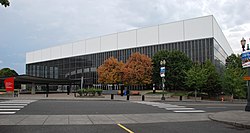This article contains promotional content .(October 2023) |
 | |
| Company type | Private |
|---|---|
| Industry | Professional services |
| Founded | 1936, in Chicago, Illinois, U.S. |
| Founders | |
| Headquarters | Chicago, Illinois, U.S. |
Area served | Worldwide |
Key people | Mustafa Abadan, William F. Baker, Thomas Behr, Keith Boswell, Carrie Byles, Larry Chien, Leo Chow, Brant Coletta, Chris Cooper, Paul Danna, Mark Sarkisian, Michael Duncan, Scott Duncan, Laura Ettelman, Xuan Fu, T.J. Gottesdiener, Gary Haney, Craig Hartman, Kent Jackson, Colin Koop, Kenneth Lewis, Adam Semel, Jonathan Stein, Douglas Voigt |
| Services | Architecture, building services/MEP engineering, graphics, interior design, structural engineering, civil engineering, sustainable design and urban design & planning |
| Revenue | $347 million (2021) |
| Website | www |
SOM, an initialism of its original name Skidmore, Owings & Merrill LLP, is a Chicago-based architectural, urban planning, and engineering firm. It was founded in 1936 by Louis Skidmore and Nathaniel Owings. In 1939, they were joined by engineer John O. Merrill. The firm opened its second office, in New York City, in 1937 and has since expanded, with offices in San Francisco, Los Angeles, Washington, D.C., London, Melbourne, Hong Kong, Shanghai, Seattle, and Dubai.
Contents
- History
- 20th century
- 21st century
- People
- Founders and notable architects
- Women at SOM
- SOM Foundation
- Awards
- Disciplines
- Urban design and planning
- Structural engineering
- Interior design
- Notable projects
- References
- External links
Notable for its role as a pioneer of modernist architecture in America and for its groundbreaking work in skyscraper design and construction, SOM has designed some of the world's most significant architectural and urban projects including several of the tallest buildings in the world: John Hancock Center (1969, second tallest in the world when built), Willis Tower (1973, tallest in the world for almost twenty-five years), One World Trade Center (2014, currently the seventh tallest in the world), and Burj Khalifa (2010, currently the world's tallest building). [1] The firm's notable current work includes the new headquarters for the Walt Disney Company, [2] the global headquarters for Citigroup, [3] Moynihan Train Hall and the expanded Penn Station complex, [4] and the restoration and renovation of the Waldorf Astoria in New York City; [5] airport projects at O'Hare International Airport, [6] Kansas City International Airport, [7] and Kempegowda International Airport; urban master plans for the Charenton-Bercy district in Paris, New Covent Garden in London, Treasure Island in San Francisco, the East Riverfront in Detroit; P.S. 62, the first net-zero-energy school in New York City; [8] and the design of the Moon Village, a concept for the first permanent lunar settlement, developed with the European Space Agency and Massachusetts Institute of Technology. [9]
SOM's multidisciplinary practice works across a range of scales and project types, providing services in architecture, building services/MEP engineering, digital design, graphics, interior design, structural engineering, civil engineering, sustainable design and urban design & planning. [10]









